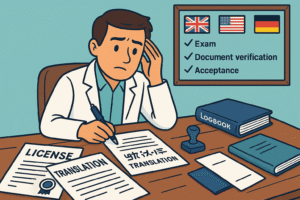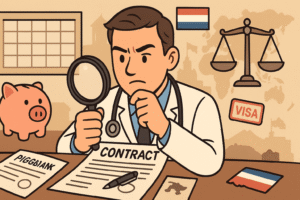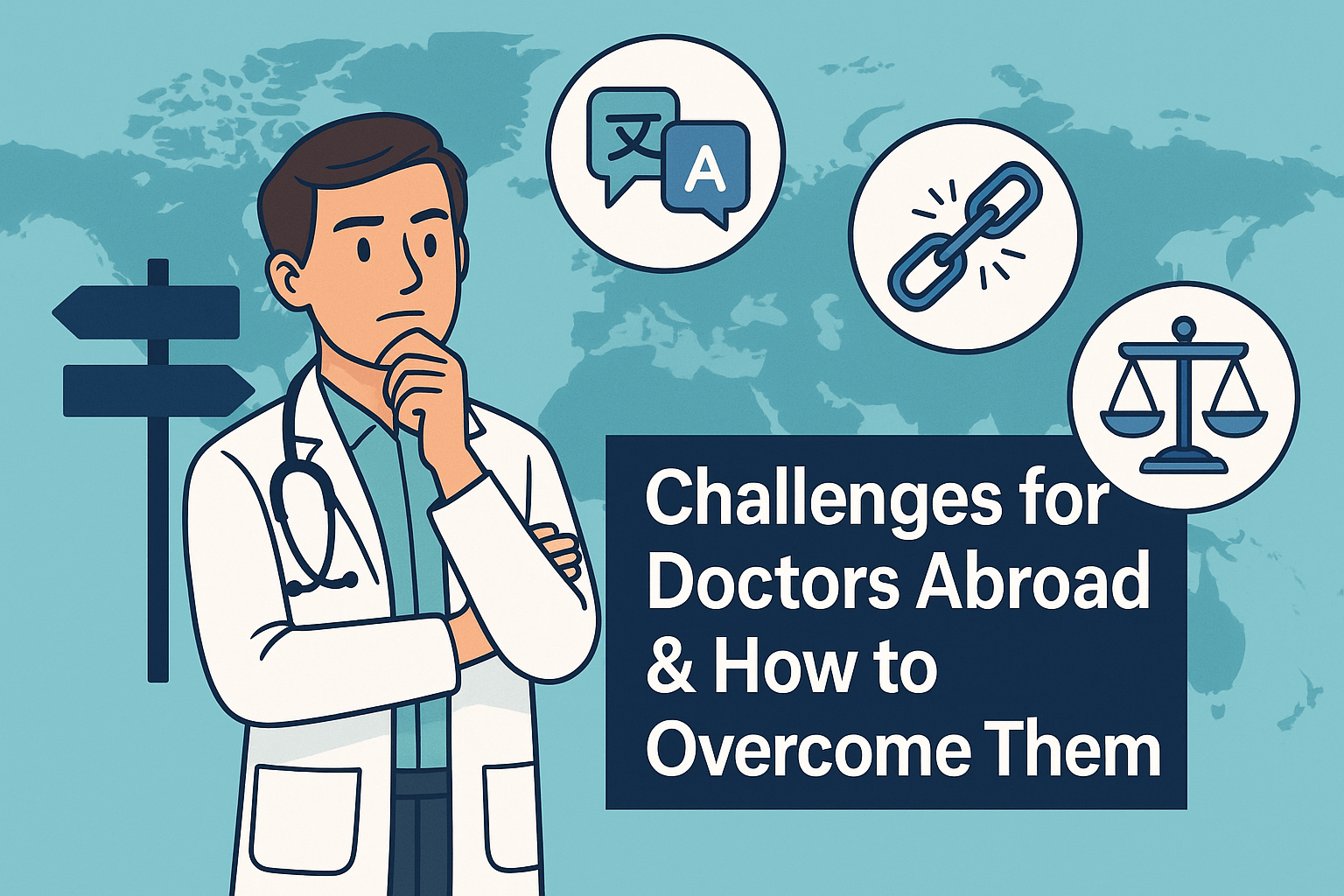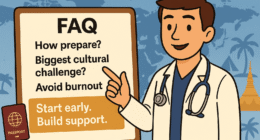Moving to a new country as a physician is a bold, life-changing decision. Yet, many doctors underestimate the challenges for doctors abroad that await them—regulatory hurdles, language barriers, cultural differences, financial pressures, and more. In this post, we explore the most pressing challenges for doctors abroad and offer actionable strategies to overcome them effectively.
Licensing, Credentialing & Regulatory Hurdles
One of the primary challenges for doctors abroad is navigating the complex web of licensing, credentialing, and registration processes in the host country.
Different exams, equivalency requirements & delays
Every country has its own medical council or regulatory body. You may be required to pass local licensing exams or submit proof of equivalency, clinical experience, or postgraduate credentials. Many foreign-trained doctors face long processing times and repeated verification of documents.
Rejections, appeals & roadblocks
Even if you fulfill all requirements, your credentialing application may be rejected or delayed due to bureaucratic issues, missing translations, or strict local rules. Some doctors need to file appeals or reapply entirely.
Solution tips:
-
Begin credentialing well before your planned move (6–12 months ahead).
-
Use certified translation services and notarize all documents.
-
Check if your host country has bridging or supervised practice periods to ease you into full licensure.

Language & Communication Barriers
Another critical category among the top challenges for doctors abroad is mastering the local language (or medical jargon) and communicating clearly with patients and colleagues.
Medical vocab, idioms & patient narratives
Even fluent speakers can struggle with dialects, idioms, patient storytelling styles, or colloquial expressions. Poor communication can lead to misdiagnosis or patient dissatisfaction.
Cultural context & nonverbal cues
Medical communication is not just words — how one greets patients, how direct you can be, how you break bad news—all of these differ culturally. Misreading nonverbal cues can create misunderstandings.
As one expert source notes, clinicians treating patients from different countries often cite language and cultural differences as key challenges. Wolters Kluwer
Solution tips:
-
Take medical-language or local dialect courses before/during relocating.
-
Observe and mirror communication styles in local settings.
-
Ask for clarifications during consultations (“Can you explain that symptom again in your own words?”).

Adapting to a New Healthcare System & Work Culture
Even after credentialing and mastering language, many foreign doctors struggle with workflow, protocols, and cultural norms in the workplace.
Different guidelines, practices & expectations
Treatment algorithms, documentation styles, electronic medical records, prescribing norms, or standard operating procedures may differ drastically. What is standard in your home country may be unusual or even frowned upon abroad.
Hierarchy, team dynamics & roles
Workplace hierarchy and professional dynamics may feel more rigid (or looser) than what you’re used to. Expectations about autonomy, decision-making, or supervision can vary.
Burnout & work overload
Many doctors abroad find themselves working longer hours or in unfamiliar systems under stress, increasing the risk of burnout.
A study of international medical graduates (IMGs) discusses that apart from licensing, clinical adaptation and work-culture issues rank among top hurdles. PMC+1
Solution tips:
-
Seek mentorship from local or other foreign doctors who have adapted.
-
Be proactive in orientation or induction programs; if none exist, request them.
-
Observe local best practices before bringing your own approach.
Cultural & Social Integration, Isolation & Homesickness
Beyond professional hurdles, challenges for doctors abroad include emotional and social struggles.
Loneliness and lack of support systems
Moving away from family and familiar social networks can lead to isolation. Cultural or language gaps may make it tough to form close friendships or social supports.
Cultural misunderstandings & microaggressions
You may face implicit bias, microaggressions, or prejudice from colleagues, patients, or staff. Misunderstandings around culture or social norms can magnify tension.
Work-life balance & self-care
Adapting to new routines, long shifts, commuting, or unfamiliar surroundings can put your well-being at risk.
Solution tips:
-
Join local social or professional networks (medical associations, social clubs).
-
Find a “buddy” system or expatriate group to share experiences.
-
Prioritize mental health: therapy, counseling, online support groups.
Financial, Contract & Legal Complexities
Financial and legal issues are often under-discussed but are among the most stressful challenges for doctors abroad.
Relocation costs & delayed income
Moving internationally may involve large upfront costs (moving, housing deposit, license fees) before your salary kicks in.
Taxation, benefits & pension systems
Your home-country taxation, social security, pension, or medical insurance plans may not carry over or may be taxed doubly. Understanding the legal framework is vital.
Contract pitfalls, visa & tenure uncertainty
Some contracts may have clauses unfavorable to foreign doctors (short-term, probationary periods, visa-linked employment). A visa denial or renewal issue could jeopardize your job.
Solution tips:
-
Consult an immigration or employment lawyer before signing contracts.
-
Negotiate relocation and financial support from your employer.
-
Budget conservatively for the first 6–12 months.

Discrimination, Recognition & Career Progression
Often underestimated, challenges for doctors abroad include barriers to recognition and professional growth.
Prejudice against foreign credentials or background
Foreign-trained doctors may be passed over for promotions or leadership roles despite equal competence, due to bias or lack of recognition.
Limited access to leadership, research or specialty roles
Some institutions may prioritize “local” doctors for coveted roles or funding opportunities.
Professional isolation & gaps in networking
Lacking established local networks can make it harder to publish, collaborate, or advance your specialty.
Solution tips:
-
Build your own reputation: publish case studies, present in conferences.
-
Volunteer for committees or leadership roles.
-
Network intentionally with local colleagues and medical societies.
How to Overcome the Challenges for Doctors Abroad — A Practical Action Plan
-
Plan early & research thoroughly
-
Understand the host country’s licensing system, exams, contract norms, and salary structure.
-
Read official medical board websites and immigration resources (for instance, the UK GMC, US ECFMG, or Australia’s AHPRA).
-
-
Mentorship & peer support
-
Reach out to doctors who have made similar transitions.
-
Join forums or social media groups (e.g., “International Doctors Forum,” specialty expatriate associations).
-
-
Bridge your skill gaps
-
Language training, communication workshops, cultural competence training.
-
CME courses in local clinical guidelines or protocols.
-
-
Negotiate favorable contract terms
-
Ask for relocation support, guaranteed induction period, visa security, probation conditions.
-
Seek clarity on salary, benefits, pension, holidays, malpractice insurance.
-
-
Prioritize well-being & integration
-
Build a social circle, maintain local hobbies, plan occasional trips home.
-
Use counseling or wellness resources proactively.
-
-
Document & reflect your journey
-
Keep a journal of cases and challenges you overcome—this becomes your portfolio and can help with future training or promotion.
-
Share your insights (blog, local forums) to increase visibility and establish your voice.
-
Conclusion
The path of a foreign doctor is full of complexity — from licensing bottlenecks to cultural integration, bias, and financial risk. But with intentional preparation, mentorship, emotional resilience, and strategic action, you can overcome those challenges for doctors abroad and thrive in your new environment. Your unique perspective as an international physician can also become your strength—bringing cross-cultural insight, adaptability, and empathy to your new healthcare system.










3 comments
Thank much..